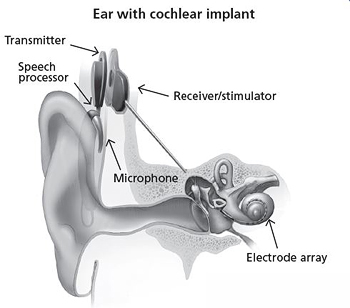
After watching the film ‘The Sound of Metal’, I realised that my previous perceptions of hearing loss didn’t consider the personal nuances and complexities that are integral to the Deaf community. The film follows a drummer who suddenly loses hearing in both ears. It is a highly personal portrayal of the different perspectives on hearing loss and the difficulties of adjusting to cochlear implants. What struck me the most (spoiler alert!) was the main character’s initial disappointment when getting fitted with a CI and the reaction of the deaf community he lived with to his decision. Following a fascinating lecture from Nicci Campbell, I decided to explore the perceptions of cochlear implants within Deaf culture further.
What Are Cochlear Implants?

Cochlear implants are small electronic devices that aid hearing acquisition and sense of sound in profoundly deaf or hard of hearing individuals (NIDCD). The instrument picks up sound through the microphone. Sound is then arranged by a speech processor and transmitted as an electrical signal to the electrode array, which sends the electrical impulses to various regions of the auditory nerve (NIDCD).
Concerningly socioeconomic status can influence outcomes of cochlear implant surgery, particularly in children (Sharma et al., 2020). I was unpleasantly surprised to learn that adults are only entitled to one CI on the NHS. It seems that whilst just one CI may provide sufficient access to auditory stimulation, this could intensify the socioeconomic divide in treatment for hearing loss and may prevent a significant increase in quality of life of individuals who can’t afford a second implant. One reality star, Daisy Kent, spoke about her hearing loss and stated that since she had the implant she doesn’t have ringing in her left ear, but “in my right ear, I have a ton of ringing”. I think this helps illustrate how only having one CI can prevent a much more desirable outcome for those who can’t afford two.
Deaf Culture
Prior to watching ‘The sound of metal’, I perhaps wouldn’t have considered that cochlear implants could be such a controversial topic. However it is clear that individual perspectives, particularly within the Deaf community, vary quite dramatically (Li et al., 2024). In the film, the main character joins a deaf school, and is told to leave once he secretly pays for cochlear implant surgery.
Some members of the deaf community see CI as a threat to Deaf culture. I think this highlights the rich history of communication and adaptations of people with hearing loss. To understand this further I have included a brilliant Ted Talk by Glenna Cooper.
I particularly enjoyed her statement that deaf people tend to have a much greater appreciation for the exchange of information, and I think this enhances her point that deaf people should not be considered as disabled, rather that they “have a different language”.
You can read more about Deaf culture here.
A Middle Ground
Sign language is perhaps the most obvious facet of Deaf culture. However, I was horrified to learn that not too long-ago many doctors told parents to discourage their deaf children from signing – and this is just one of the reasons why I can appreciate the sensitivity of assuming all deaf people may benefit from auditory aids, which may lead to a decline in the use of sign language. However, it is important to appreciate experiences where cochlear implants have created a unique path between both ways of life – Heather Artinian, a lawyer who was born deaf and to deaf parents, decided to get a cochlear implant surgery at age 10, against her parents initial wishes. She describes how she operates in the ‘Heather world’ where her upbringing amongst a deaf community, and her implant, allows her to enjoy aspects of both the hearing and the deaf world. I would highly encourage listening to her engaging and positive perspective on being in ‘not the hearing or deaf world.’ https://youtu.be/jhm5OaXJVMQ?si=TU_DSGcD-m-fEeqq
In an ideal world, we would all be more accommodating of Deaf culture, and more people would aim to learn sign language.
You can follow this link to find out how to start learning sign language. You can also learn how to sign your own name, and other words here.

Celebrating diversity and appreciating different ways of experiencing the world enhances new perspectives and solutions of healthcare. Following utilitarian beliefs that aim to serve the majority threatens minority cultures, such as Deaf culture, which could be excluded when attempting to ‘fix’ what many people consider a significant part of their identity. I believe that whilst the development of CI has provided many people with access to a better quality of life, reduced social isolation and discomfort, we shouldn’t immediately assume that anatomical differences need to be universally ‘fixed’, rather than accommodated and respected, whether that be through learning BSL or providing equitable access to assisted hearing technology.
Links
NIDCD https://www.nidcd.nih.gov/health/cochlear-implants#:~:text=A%20cochlear%20implant%20is%20a,the%20skin%20(see%20figure).
Sharma et al (2020) https://doi.org/10.1016/j.ijporl.2020.109984
Li et al (2024) https://doi.org/10.1038/s41598-024-55006-8
Very well written, with an excellent format and images. You’ve included interesting statistics and related it to personal ideas which…
This is a very well written blog, the format is as if you are talking directly to me. The ideas…
Love the Batman GIF :)
This is an excellent, well written blog. The narrative is engaging and easy to follow. It could be improved by…
This is a well-communicated blog. The it is written well with good use of multimedia. It could be improved with…